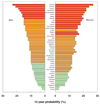The impact of fragility fracture and approaches to osteoporosis risk assessment worldwide
- PMID: 28119181
- PMCID: PMC5420448
- DOI: 10.1016/j.bone.2017.01.024
The impact of fragility fracture and approaches to osteoporosis risk assessment worldwide
Abstract
Osteoporosis constitutes a major public health problem, through its association with age-related fractures, particularly of the hip, vertebrae, distal forearm and humerus. Substantial geographic variation has been noted in the incidence of osteoporotic fractures worldwide, with Western populations (North America, Europe and Oceania), reporting increases in hip fracture throughout the second half of the 20th century, with a stabilisation or decline in the last two decades. In developing populations however, particularly in Asia, the rates of osteoporotic fracture appears to be increasing. The massive global burden consequent to osteoporosis means that fracture risk assessment should be a high priority among health measures considered by policy makers. The WHO operational definition of osteoporosis, based on a measurement of bone mineral density (BMD) by dual-energy X-ray absorptiometry (DXA), has been used globally since the mid-1990s. However, although this definition identifies those at greatest individual risk of fracture, in the population overall a greater total number of fractures occur in individuals with BMD values above the threshold for osteoporosis diagnosis. A number of web-based tools to enable the inclusion of clinical risk factors, with or without BMD, in fracture prediction algorithms have been developed to improve the identification of individuals at high fracture risk, the most commonly used globally being FRAX®. Access to DXA, osteoporosis risk assessment, case finding and treatment varies worldwide, but despite such advances studies indicate that a minority of men and women at high fracture risk receive treatment. Importantly, research is ongoing to demonstrate the clinical efficacy and cost-effectiveness of osteoporosis case finding and risk assessment strategies worldwide. The huge burden caused by osteoporosis related fractures to individuals, healthcare systems and societies should provide a clear impetus for the progression of such approaches.
Keywords: Assessment; Epidemiology; Geography; High fracture risk; Osteoporosis.
Copyright © 2017 Elsevier Inc. All rights reserved.
Figures





References
-
- Consensus development conference: diagnosis, prophylaxis, and treatment of osteoporosis. Am J Med. 1993;94(6):646–650. - PubMed
-
- World Health Organization Study G. Assessment of fracture risk and its application to screening for postmenopausal osteoporosis. 1994 - PubMed
-
- Kanis JA, et al. The use of clinical risk factors enhances the performance of BMD in the prediction of hip and osteoporotic fractures in men and women. Osteoporos Int. 2007;18(8):1033–1046. - PubMed
Publication types
MeSH terms
Grants and funding
- MC_U147585827/MRC_/Medical Research Council/United Kingdom
- 21231/ARC_/Arthritis Research UK/United Kingdom
- 201222/Z/16/Z/WT_/Wellcome Trust/United Kingdom
- MC_U147585819/MRC_/Medical Research Council/United Kingdom
- 17702/ARC_/Arthritis Research UK/United Kingdom
- MC_UP_A620_1014/MRC_/Medical Research Council/United Kingdom
- HTA/10/33/04/DH_/Department of Health/United Kingdom
- G0400491/MRC_/Medical Research Council/United Kingdom
- MC_U147585824/MRC_/Medical Research Council/United Kingdom
- 10/33/04/DH_/Department of Health/United Kingdom
- MC_UU_12011/1/MRC_/Medical Research Council/United Kingdom
LinkOut - more resources
Full Text Sources
Other Literature Sources
Medical

